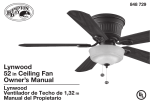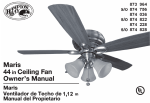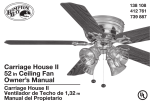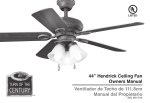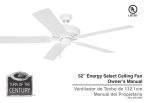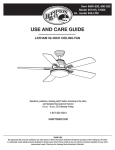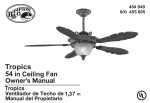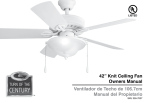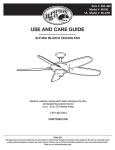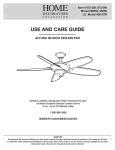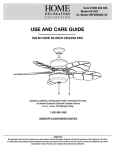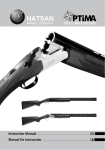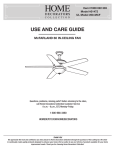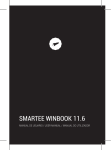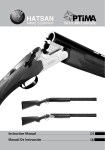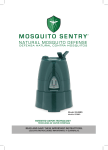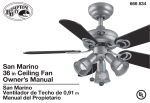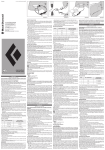Download 52” Novella Ceiling Fan Owners Manual Ventilador de
Transcript
LISTED 52” Novella Ceiling Fan Owners Manual Ventilador de Techo de 132.1cm Manual del Propietario SKU 355-6791 52” Novella Ceiling Fan Table of Contents Safety Rules................................... 1 Unpacking Your Fan...................... 2 Installing Your Fan........................ 3 Operating Your Fan....................... 8 Care of Your Fan............................ 9 Troubleshooting............................ 9 Specifications................................ 10 Warranty Information.................... 11 QUESTIONS, PROBLEMS, MISSING PARTS: Please do not return to retailer: Call 1-800-749-3267 for any missing parts or questions regarding installation. Please reference your SKU (355-6791) or UPC (082392 636548). UL Model No. EF600M-52 READ AND SAVE THESE INSTRUCTIONS 1. To reduce the risk of electric shock, ensure electricity has been turned off at the circuit breaker or fuse box before beginning. 2. All wiring must be in accordance with the National Electrical Code ANSI/NFPA 70-1999 and local electrical codes. Electrical installation should be performed by a qualified licensed electrician. 3. WARNING: To reduce the risk of fire or electrical shock, do not use this fan with any solid-state fan speed control device. 4. CAUTION: To reduce the risk of personal injury, use only the screws provided with the outlet box. 5. The outlet box and support structure must be securely mounted and capable of reliably supporting a minimum of 35 pounds. Use only UL Listed outlet boxes marked “FOR FAN SUPPORT.” 6. The fan must be mounted with a minimum of 7 feet clearance from the trailing edge of the blades to the floor. 7. Do not operate the reverse switch while fan blades are in motion. Fan must be turned off and blades stopped before reversing blade direction. 8. Avoid placing objects in the path of the blades. TO REDUCE THE RISK OF FIRE, ELECTRIC SHOCK OR PERSONAL INJURY, MOUNT FAN TO OUTLET BOX MARKED “ACCEPTABLE FOR FAN SUPPORT” WITH THE SCREWS PROVIDED WITH THE OUTLET BOX. MOST OUTLET BOXES COMMONLY USED FOR THE SUPPORT OF LIGHTING FIXTURES ARE NOT ACCEPTABLE FOR FAN SUPPORT AND MAY NEED TO BE REPLACED. CONSULT A QUALIFIED ELECTRICIAN IF IN DOUBT. Safety Rules 1. 9. To avoid personal injury or damage to the fan and other items, be cautious when working around or cleaning the fan. 10.Do not use water or detergents when cleaning the fan or fan blades. A dry dust cloth or lightly dampened cloth will be suitable for most cleaning. 11.After making electrical connections, spliced conductors should be turned upward and pushed carefully up into outlet box. The wires should be spread apart with the grounded conductor and the equipment-grounding conductor on one side of the outlet box. 12.Electrical diagrams are for reference only. Light kits that are not packed with the fan must be UL listed and marked suitable for use with the model fan you are installing. Switches must be UL general use switches. Refer to the instructions packaged with the light kits and switches for proper assembly. Use type A 40W MAX. BULBS (supplied). 13.All set screws must be checked and tightened where necessary before installation. TO REDUCE THE RISK OF PERSONAL INJURY, DO NOT BEND THE BLADE BRACKETS (ALSO REFERRED TO AS “FLANGES”) DURING ASSEMBLY OR AFTER INSTALLATION. DO NOT INSERT OBJECTS IN THE PATH OF THE BLADES. 2. Unpacking Your Fan Unpack your fan and check the contents. You should have the following items: 1. 2. 3. 4. 5. Fan Motor Assembly Mounting Bracket Blades (5) Blade Arms (5) Motor Housing 6. Light Kit 7. Bulbs (4) 8. Glass Shades (4) IMPORTANT: THIS PRODUCT AND/OR COMPONENTS ARE COVERED BY ONE OR MORE OF THE FOLLOWING U.S. PATENTS: 5,947,436; 5,988,580; 5,971,573; 6,010,110; 6,010,306; 6,039,541; 6,046,416 AND OTHER PATENTS PENDING. a. Blade Attachment Hardware (15 screws) b. Electrical Hardware & Balancing Kit (Blade Balancing Kit, 3 Plastic Wire Connectors, 1 Pull Chain for the Fan, 1 Pull Chain for the Light Kit) If you need an extra switch cup (or cover) for the non-light option, please call 1-800-283-6513 (M–F 9:00am to 4:40pm EST). www.gpwarranty.com email:[email protected] Tools Required Phillips screw driver, straight slot screw driver, adjustable wrench, step ladder, and wire cutters. Figures 1 and 2 are examples of different ways to mount the outlet box. Mounting Options Outlet Box If there isn’t an existing outlet box, then read the following instructions. Disconnect the power by removing fuses or turning off circuit breakers. Figure 3 To hang your fan where there is an existing fixture but no ceiling joist, you may need an installation hanger bar as shown in Figure 3. Secure the outlet box directly to the building structure. Use the appropriate fasteners and building materials. The outlet box and its support must be able to fully support the moving weight of the fan (at least 35 lbs.) Do not use plastic outlet boxes. TO REDUCE THE RISK OF FIRE, ELECTRIC SHOCK OR PERSONAL INJURY, MOUNT FAN ONLY TO AN OUTLET BOX MARKED ACCEPTABLE FOR FAN SUPPORT AND USE THE MOUNTING SCREWS PROVIDED WITH THE OUTLET BOX. OUTLET BOXES COMMONLY USED FOR THE SUPPORT OF LIGHTING FIXTURES MAY NOT BE ACCEPTABLE FOR FAN SUPPORT AND MAY NEED TO BE REPLACED. CONSULT A QUALIFIED ELECTRICIAN IF IN DOUBT. Installing Your Fan 3. Figure 1 Outlet Box Figure 2 4. Hanging the Fan REMEMBER to turn off the power. Follow the steps below to hang your fan properly. 1. Attach the mounting plate to the outlet box using the two screws and washers provided with the outlet box (Figure 5). For best performance, be sure the mounting plate is level and secured firmly against the ceiling. 2. Carefully lift the motor assembly (without the blades) and insert the T section of the motor housing plate into the slot in the mounting bracket as shown in Figure 6. You are now ready to make the electrical connections. Wire your fan according to the instructions in the following section. Outlet Box Mounting Plate Mounting Screws And Washers (Provided With Outlet Box) Leveling Washer (If Required) Not Included Isolation Pads Figure 4 Mounting Plate Motor Housing Plate Figure 5 Making the Electrical Connections REMEMBER to disconnect the power. If you feel you do not have enough electrical wiring knowledge or experience, have your fan installed by a licensed electrician. Follow the steps below to connect the fan to your household wiring. Use the wire connecting nuts supplied with your fan. Secure the connectors with electrical tape. Make sure there are no loose strands or connections. 1. Connect the ground conductor of the 120v supply (this may be a bare wire or a wire with green colored insulation) to the green ground leads from the motor bracket and the mounting plate of the fan (Figure 6). 2. Connect the fan motor white wire to the supply white (neutral) wire using a wire nut supplied (Figure 6). 3. Connect the fan motor black and blue wires to the supply black (hot) wire using a wire nut supplied (Figure 6). 4. After connecting the wires, spread them apart so that the green and white wires are on one side of the outlet box and the black wire is on the other side. 5. Turn the wire connecting nuts upward and push the wiring into the outlet box. 6. Remove screws on the mounting plate opposite the T-section. Lift the motor and align the screw holes of the motor housing plate with the holes in the mounting plate. Re-install the screws removed from the motor housing plate and tighten screws firmly. 5. BLACK WHITE SUPPLY CIRCUIT Ground Conductor TO REDUCE RISK OF FIRE OR ELECTRIC SHOCK, DO NOT USE A SOLID STATE SPEED CONTROL WITH THIS FAN. IT WILL PERMANENTLY DAMAGE THE ELECTRONIC CIRCUITRY. Motor Housing Plate Hanger Bracket Washers BLUE BLACK WHITE GREEN Outlet Box Green Ground Lead EACH WIRE NUT (WIRE CONNECTOR) SUPPLIED WITH THIS FAN IS DESIGNED TO ACCEPT UP TO ONE 12 GAUGE HOUSE WIRE AND TWO WIRES FROM THIS FAN. IF YOU HAVE LARGER THAN 12 GAUGE HOUSE WIRING OR MORE THAN ONE HOUSE WIRE TO CONNECT TO THE FAN WIRING, CONSULT AN ELECTRICIAN FOR THE PROPER SIZE WIRE NUTS TO USE. Screws Motor Figure 7 ELECTRICAL DIAGRAMS ARE FOR REFERENCE ONLY. OPTIONAL USE OF ANY LIGHT KIT SHALL BE UL LISTED AND MARKED SUITABLE FOR USE WITH THIS FAN. BLUE BLACK Finishing the Installation WHITE WHITE Diagram indicates light kit wiring. Figure 6 1. Swing the motor assembly up into position under the mounting bracket. Secure the bracket to the plate with the screws and washers provided (Figure 7). 2. Carefully lift the motor housing onto the mounting plate, properly align the holes and tighten the motor housing with the four screws and washers supplied (Figure 8). Screws And Washers Figure 8 6. Attaching the Fan Blades Rubber Pad NOTE: Your fan blades are reversible. Select the blade finish which best accentuates you decor. 1. Attach blade to blade bracket using the screws provided as shown in figure 9. Insert a screw into the bracket. Repeat for the two remaining screws. 2. Tighten each screw securely. 3. Fasten the blade assembly to the motor using the screws supplied (Figure 10). 4. Repeat steps 1-3 for the remaining blades. Fiber Washer Fan Blade Mounting Screw Blade Bracket Figure 9 Figure 10 Attaching the Light Kit 1. Remove the three mounting screws on the switch cap of the light kit below the motor. 2. Connect the wires exiting the bottom of the motor with the light kit by connecting the motor with the wires from the light kit. 3. Slide the light kit up and secure it to the switch cup using the three screws that were removed in step 1. 4. Insert the glass shade into the glass holder by carefully squeezing the steel tensioners on the light fixture socket together. 5. Gently slide the glass shade over the steel tensioners. Make sure the glass shade is fully inserted into the socket for a secure fit. Repeat for the remaining glass shades. 6. With the power off, insert the light bulbs (included) into the light kit sockets. Max 40 watts medium base bulbs. To remove the glass shades, gently slide the shade partially from the socket and squeeze the exposed steel tensioners. Remove the shade and release the tensioners. 7. Blade Balancing All blades are grouped by weight. Because natural woods vary in density, the fan may wobble even though the blades are weight matched. The following procedure should correct most fan wobble. Check after each step. 1. Check that all blade screws are secure. 2. Most fan wobble problems are caused when blade levels are unequal. Check this level by selecting a point on the ceiling above the tip of one of the blades. Measure from a point on the center of each blade to the point on the ceiling. Measure this distance as shown in Figure 11. Rotate the fan until the next blade is positioned for measurement. Repeat for each blade. Measurement deviations should be within 1/8”. Run the fan for 10 minutes. 3. Use the enclosed Blade Balancing Kit if the blade wobble is still noticeable. Figure 11 TO REDUCE THE RISK OF PERSONAL INJURY, DO NOT BEND THE BLADE HOLDERS WHILE INSTALLING, BALANCING THE BLADES, OR CLEANING THE FAN. DO NOT INSERT FOREIGN OBJECTS BETWEEN ROTATING BLADES. 8. Operating Your Fan WAIT FOR THE FAN TO STOP BEFORE REVERSING THE DIRECTION OF THE BLADE ROTATION. Turn on the power and check the operation of the fan. The pull chain controls the fan speed as follows: 1 pull - High, 2 pulls - Medium, 3 pulls - Low and 4 pulls - Off. The other pull chain controls the light On and Off. Warm weather - (Forward) A downward air flow creates a cooling effect as shown in Figure 12. This allows you to set your air conditioner on a higher setting without affecting your comfort. Speed settings for warm or cool weather depend on factors such as room size, ceiling height, number of fans, and so on. The slide switch controls the direction forward (switch down) or reverse (switch up). Figure 12 Cool weather - (Reverse) An upward air flow moves warm air off the ceiling are as shown in Figure 13. This allows you to set your heating unit on a lower setting without affecting your comfort. Figure 13 Care of Your Fan Here are some suggestions to help you maintain your fan. 1. Because of the fan’s natural movement, some connections may become loose. Check the support connections, brackets, and blade attachments twice a year. Make sure they are secure. (It is not necessary to remove the fan from the ceiling.) 2. Clean your fan periodically to help maintain its new appearance over the years. Do not use water when cleaning, this could damage the motor, or the wood or possibly cause an electrical shock. Use only a soft brush or lintfree cloth to avoid scratching the finish. The plating is sealed with a lacquer to minimize discoloration or tarnishing. Warning - Make sure the power is off before cleaning your fan. 3. You can apply a light coat of furniture polish to the wood for additional protection and enhanced beauty. Cover small scratches with a light application of shoe polish. 4. There is no need to oil your fan. The motor has permanently lubricated sealed ball bearings. Troubleshooting ProblemSolution Fan will not start 1. Check the main and branch circuit fuses or breakers 2. CAUTION: Make sure main power is off. Check the line wire connections to the fan and switch wire connections in the switch housing. Fan sounds noisy 1. Make sure all motor housing screws are snug. 2. Make sure the screws that attach the fan blade bracket to the motor hub are tight. 3. Make sure the wire nut connections are not rattling against each other or the interior wall of the switch housing. CAUTION: Make sure the power is off. 4. Allow a 24-hour “breaking in” period. Most noises associated with a new fan disappear during this time. 5. If using the Ceiling Fan light kit, make sure the tensioners or screws securing the glassware are tight. Check that the light bulb is also secure. 6. Make sure the canopy is a short distance from the ceiling. It should not touch the ceiling. 7. Make sure your outlet box is secure and rubber isolator pads were used between the mounting bracket and outlet box. 8. Make sure pull chains are not vibrating against glass or housing. MAKE SURE THE POWER IS OFF AT THE ELECTRICAL PANEL BOX BEFORE YOU ATTEMPT TO MAKE ANY REPAIRS. REFER TO THE SECTION, “MAKING ELECTRICAL CONNECTIONS.” 9. 10. Specifications FAN SIZE 52” SPEED VOLTS AMPS WATTS RPM CFM Low 120 0.26 13 70 1820 Med 120 0.39 30 120 3150 High 120 0.52 60 165 4740 NET WEIGHT GROSS WEIGHT CUBE FEET 18.48 LBS 20.9 LBS 1.77 These are approximate measures. They do not include Amps and Wattage used by the light kit. Limited Lifetime Warranty Lifetime Warranty on Motor Warranty Information 11. The manufacturer warrants the fan motor to be free from defects in workmanship and material present at time of the shipment from the factory for a lifetime after the date of purchase by the original purchaser. The manufacturer also warrants that all other fan parts, excluding any glass or acrylic blades, to be free from defects in workmanship and material IMPORTANT NOTE: at the time of shipment from the factory for a period of one year after the date of purchase To ensure warranty service, if ever by the original purchaser. We agree to correct such defects without charge or at our option necessary, please register your fan at: replace with a comparable or superior model if the product is returned to the manufacturer. gpwarranty.com To obtain warranty service, you must present a copy of the receipt as proof of purchase. All costs of removing and reinstalling the product are your responsibility. Damage to any You must present a copy of the original part such as by accident or misuse or improper installation or by affixing any accessories, is not covered by this warranty. Because of varying climatic conditions, this warranty does purchase receipt to obtain warranty service. not cover any changes in plated finishes, including rusting, pitting, corroding, tarnishing or peeling. Brass finishes of this type give their longest useful life when protected from varying G.P. WARRANTY SERVICE CENTER, INC. weather conditions. A certain amount of “wobble” is normal and should not be considered WARRANTY SECTION a defect. Servicing performed by unauthorized persons shall render the warranty invalid. 1951 N.W. 22nd STREET There is no other express warranty. The manufacturer hereby disclaims any and all warFORT LAUDERDALE, FLORIDA 33311 ranties, including but not limited to, those of merchantability and fitness for a particular purpose to the extent permitted by law. The duration of any implied warranty which cannot be disclaimed is limited to the time period as specified in the express warranty. Some states do not allow limitation on how long an implied warranty lasts, so the above limitation may not apply to you. The manufacturer shall not be liable for incidental, consequential, or special damages arising out of or in connection with product use or performance except as may otherwise be accorded by law. Some states do not allow the exclusion of incidental or consequential damages, so the above exclusion or limitation may not apply to you. This warranty gives specific legal rights, and you may also have other rights which vary form state to state. This warranty supersedes all prior warranties. Shipping costs for any return of product as part of a claim on the warranty must be paid by the customer. Novella de 52” Ventilador de techo Índice Normas de seguridad...................... 1 Cómo desempacar el ventilador.... 2 Cómo instalar el ventilador............ 3 Cómo operar el ventilador.............. 8 Cuidado del ventilador.................... 9 Solución de problemas................... 9 Especificaciones............................. 10 Información de garantía.................. 11 ¿PREGUNTAS, PROBLEMAS O PIEZAS FALTANTES? Por favor, no devuelva al vendedor minorista: Llame a 1-800-749-3267 para cubrir las partes faltantes o cuestiones relacionadas con la instalación. Por favor usa como referencia el Nº de SKU (355-6791) o UPC (082392 636548). Número de Modelo UL EF600M-52 1. Normas de seguridad LEE LAS INSTRUCCIONES Y GUÁRDALAS 1. Para disminuir el riesgo de descarga eléctrica, asegúrate de que la electricidad ha sido apagada en el cortacircuitos o la caja de fusibles antes de comenzar la instalación. 2. Todo el cableado debe cumplir con el Código Nacional de Electricidad ANSI/NFPA 70-1999 y con los códigos locales de electricidad. La instalación eléctrica debe ser hecha por un electricista certificado y calificado. 3. ADVERTENCIA:Para disminuir el riesgo de incendio o descarga eléctrica este ventilador sólo debe ser usado con un control de velocidad con el N.o de pieza FAN-HD, fabricado por Chia Wei Electric Co., Ltd. 4. PRECAUCIÓN: Para reducir el riesgo de lesiones físicas, usa sólo los tornillos provistos con la caja eléctrica. 5. La caja eléctrica y estructura de soporte deben montarse de forma segura y tener capacidad para sostener de manera confiable un mínimo de 35 libras. Usa solamente cajas eléctricas aprobadas por UL marcadas como “PARA SOPORTE DE VENTILADOR”. 6. El ventilador debe ir montado con un mínimo de 7 pies de separación entre el borde trasero de las aspas y el piso. 7. No operar el interruptor de reversa mientras las aspas del ventilador estén en movimiento. El ventilador debe estar PARA REDUCIR EL RIESGO DE INCENDIO, DESCARGA ELÉCTRICA O LESIONES PERSONALES, MONTA EL VENTILADOR SOBRE UNA CAJA ELÉCTRICA MARCADA COMO “APROBADA COMO SOPORTE DE VENTILADOR” Y USA LOS TORNILLOS DE MONTAJE QUE VIENEN CON LA MISMA. LAS CAJAS ELÉCTRICAS UTILIZADAS COMÚNMENTE PARA EL SOPORTE DE ARTÍCULOS DE ILUMINACIÓN PUEDEN NO SERVIR COMO SOPORTE DE VENTILADOR, Y TAL VEZ DEBAN REEMPLAZARSE. EN CASO DE DUDA, CONSULTA A UN ELECTRICISTA CALIFICADO. apagado y las aspas detenidas antes de invertir la dirección del movimiento. 8. Evita colocar objetos en la trayectoria de las aspas. 9. Para evitar lesiones, o daños al ventilador y otros objetos; ten cuidado al trabajar cerca del ventilador o al limpiarlo. 10.No usar agua o detergentes para limpiar el ventilador o las aspas. En general a la hora de limpiar, bastará con usar un paño seco o ligeramente humedecido. 11.Después de concluir con las conexiones eléctricas, debes voltear los conductores empalmados hacia arriba y empujarlos con cuidado hacia dentro de la caja eléctrica. Los cables deben estar separados, con el cable a tierra y el conductor a tierra del equipo hacia uno de los lados de la caja eléctrica. 12.Los diagramas eléctricos son sólo una referencia. Los kits de luces no empaquetados con el ventilador deben estar aprobados por UL y marcados como apropiados para ser usados con el modelo de ventilador a instalar. Los interruptores deberán estar clasificados por el UL como de Uso General. Consulta las instrucciones adjuntas a los kits de luces e interruptores para obtener información sobre el ensamblaje adecuado. Usa bombillas de tipo A de 40 vatios máximo (incluidas). 13.Todos los tornillos colocados se deben verificar y ajustar donde sea necesario antes de la instalación. PARA REDUCIR EL RIESGO DE LESIONES PERSONALES, NO DOBLAR LOS BRAZOS DE LAS ASPAS (TAMBIÉN LLAMADOS “REBORDES”) DURANTE O DESPUÉS DE LA INSTALACIÓN. EVITA COLOCAR OBJETOS EN LA TRAYECTORIA DE LAS ASPAS. Cómo desempacar el ventilador 2. Desempaca tu ventilador y revisa el contenido. Deberá tener las siguientes piezas: 1. 2. 3. 4. 5. Ensamblado del motor Soporte de montaje Aspas (5) Soportes del aspa (5) Carcasa del motor 6. Kit de Luces 7. Bombillas (4) 8. Pantallas de vidrio (4) IMPORTANTE: ESTE PRODUCTO Y/O SUS COMPONENTES ESTÁN PROTEGIDOS POR UNA O MÁS DE LAS SIGUIENTES PATENTES DE EE.UU.: 5,947,436; 5,988,580; 5,971,573; 6,010,110; 6,010,306; 6,039,541; 6,046,416 Y OTRAS PATENTES PENDIENTES. a. Herrajes de montaje de aspas (15 tornillos) b. Herrajes eléctricos y kit de compensación (Kit de compensación de aspas, 3 conectores plásticos de cables, 1 cadena del ventilador para halar, 1 cadena del kit de luces para halar) Si usted necesita una caja del interruptor adicional para la opción de la no-luz, llame por favor al 1-800-283-6513 (lunes a viernes de 9:00 a 4:40 P.M. EST). www.gpwarranty.com email:[email protected] 3. Cómo instalar el ventilador Herramientas necesarias Destornillador Phillips, destornillador plano, llave ajustable, escalera de tijera y cortacables. Las figuras 1, 2 y 3 son ejemplos de diferentes formas de montar la caja eléctrica. Opciones de montaje Caja eléctrica Figura 3 Si no hay una caja de montaje existente, entonces lee las siguientes instrucciones. Desconecta la energía retirando los fusibles o apagando los cortacircuitos. Para colgar tu ventilador donde haya una lámpara pero ninguna viga de techo, tal vez necesites una barra colgante de instalación como se muestra en la Figura 3. Asegura la caja eléctrica directamente a la estructura del edificio. Usa sujetadores y materiales de construcción apropiados. La caja eléctrica y su soporte deben sostener completamente el peso en movimiento del ventilador (al menos 35 libras). No uses cajas eléctricas de plástico. PARA REDUCIR EL RIESGO DE INCENDIO, DESCARGA ELÉCTRICA O LESIONES PERSONALES, MONTA EL VENTILADOR SÓLO SOBRE UNA CAJA ELÉCTRICA MARCADA COMO “APROBADA COMO SOPORTE DE VENTILADOR” Y USA LOS TORNILLOS DE MONTAJE QUE VIENEN CON LA MISMA. LAS CAJAS ELÉCTRICAS UTILIZADAS COMÚNMENTE PARA EL SOPORTE DE ARTÍCULOS DE ILUMINACIÓN PUEDEN NO SERVIR COMO SOPORTE DE VENTILADOR, Y TAL VEZ DEBAN REEMPLAZARSE. EN CASO DE DUDA, CONSULTA A UN ELECTRICISTA CALIFICADO. Caja eléctrica Figura 1 Caja eléctrica Figura 2 4. Colgando el ventilador Placa de montaje RECUERDE: De desconectar la electricidad. Siga los pasos Indicados para colgar su ventilador correctamente. 1. Anexe el Plato de montaje a la caja de montaje utilizando los dos tornillos y las arandelas provistas con la caja eléctrica (vea figura 5). Para un mejor funcionamiento, asegúrese que el plato de montaje este nivelado y firmemente contra el techo. 2. Cuidadosamente levante el ensamblaje del motor (sin las aspas) e inserte la sección T de la placa de la caja del motor en la ranura del soporte de montaje como lo muestra la figura 6. Usted esta ahora listo para hacer las conexiones eléctricas. Realice las conexiones como lo indica las instrucciones en la siguiente sección. Caja eléctrica Placa de montaje Arandelas niveladoras (Si es necesario) No Incluido Tornillos y arandelas de montaje Almohadilla de Aislamiento (Incluido en la caja eléctrica) Figura 4 Plato de montaje del Motor Cómo hacer las conexiones eléctricas Figura 5 RECUERDA desconectar la electricidad. Si crees que no tienes suficiente experiencia o conocimientos en cableado eléctrico, contrata a un electricista con licencia para que instale el ventilador. Sigue estos pasos para conectar tu ventilador a tu circuito doméstico. Usa las tuercas de conexión de cables que vienen con tu ventilador. Asegura los conectores con cinta aislante. Asegúrate de que no existan conexiones o cables sueltos. 1. Conecta el conductor a tierra del cable de 120 voltios (puede ser un cable desnudo o un cable con aislante verde) a los cables terminales a tierra verdes del soporte del motor y la placa de montaje del ventilador (Figura 6). 2. Conecta el cable blanco del motor del ventilador al cable blanco de suministro (neutro) usando la tuerca de cable provista (Figura 6). 3. Conecta el cable negro y el azul del motor del ventilador al cable negro de suministro de energía (positivo) usando la tuerca de cable incluida (Figura 6). 4. Después de conectar los cables, sepáralos de manera que los cables verde y blanco queden de un lado de la caja eléctrica y el cable negro del otro. 5. Gira las tuercas de conexión del cable hacia arriba y coloca el cableado dentro de la caja eléctrica. 6. Quite los tornillos de la placa de montaje frente a la T-sección. Levante el motor y alinear los agujeros de los tornillos de la placa de la caja del motor con los agujeros en la placa de montaje. Vuelva a instalar los tornillos que quitó de la placa de la caja del motor y apriete los tornillos con firmeza. 5. NEGRO BLANCO CIRCUITO DE SUMINISTRO Conductor a tierra AZUL NEGRO VERDE BLANCO AZUL NEGRO Caja eléctrica Cable verde terminal a tierra PARA REDUCIR EL RIESGO DE INCENDIO O DESCARGA ELÉCTRICA, NO UTILICES ESTE VENTILADOR CON NINGÚN DISPOSITIVO DE CONTROL DE VELOCIDAD DE ESTADO SÓLIDO, DE MONTAJE EN PARED. EL CIRCUITO ELECTRÓNICO SE DAÑARÁ EN FORMA PERMANENTE. CADA TUERCA DEL CABLE (CONECTOR DE CABLE) PROVISTA CON ESTE VENTILADOR ESTÁ DISEÑADA PARA ACEPTAR CABLES DOMÉSTICOS DE MÁXIMO UN CALIBRE 12 Y DOS CABLES DEL VENTILADOR. SI TIENES UN CABLEADO DOMÉSTICO DE CALIBRE SUPERIOR A 12, O MÁS DE UN CABLE DOMÉSTICO PARA CONECTAR EL CABLEADO DEL VENTILADOR, CONSULTA A UN ELECTRICISTA PARA EL TAMAÑO ADECUADO DE TUERCAS DE CABLE. LOS DIAGRAMAS ELÉCTRICOS SON SÓLO UNA REFERENCIA. EL USO OPCIONAL DE KITS DE LUCES DEBE ESTAR APROBADO POR UL Y ESTARÁ MARCADO COMO ADECUADO PARA SER USADO EN ESTE VENTILADOR. BLANCO BLANCO El diagrama muestra un kit de luces. Figura 6 Finalizar la instalación del ventilador 1. Mueva el ensamblaje del motor hacia arriba y que quede debajo del soporte de montaje. Asegure el soporte a la placa con los tornillos y arandelas suministradas (Figura 7). 2. Levante cuidadosamente la caja del motor hacia el plato de montaje, alinee correctamente los agujeros y apriete la caja del motor con los tornillos y las arandelas suministradas (Figura 8). Plato de montaje del Motor Placa de montaje Arandelas Tornillos Motor Figura 7 Tornillos y arandelas Figura 8 Cómo montar las aspas del ventilador NOTA: Las aspas de tu ventilador son reversibles. Elige el acabado del aspa que mejor resalte tu decoración. 1. Fija el aspa a su soporte con los tornillos provistos según se muestra en la Figura 9. Inserta el tornillo en el soporte. Repite para los otros dos tornillos. 2. Aprieta todos los tornillos de manera firme. 3. Fasten the blade assembly to the motor using the screws supplied (Figura 10). 4. Repite los pasos 1, 2 y 3 para las aspas restantes. Tornillo de montaje Arandelas de fibra Soporte de aspa Aspa Figura 9 Almohadilla de Goma Figura 10 Instalando El Kit de Luces 1. Remueva los tres tornillos de montaje de la caja de interruptores del juego de luces debajo del motor. 2. Conecte los cables salientes de la parte Inferior del motor con el juego de luces. 3. deslice el juego de luces hacia arriba y asegúrelo a la caja de interruptores utilizando los tres tornillos que fueron removidos en el paso 1. 4. Inserte la lámpara de vidrio en el sostenedor de la lámpara y cuidadosamente apriete junto los tensores de hierro en el zócalo del accesorio del juego de luces. 5. Suavemente deslice la lámpara de vidrio sobre los tensores de hierro. Asegúrese de que la lámpara de vidrio este insertada correctamente en el zócalo para un ajuste seguro. Repita para las lámparas de vidrios restantes. 6. Con la energía apagada, inserte las bombillas de 40 W máximo (incluidas) en los zócalos del juego de luces. Para quitar la lámpara de vidrio, deslice suavemente la lámpara de vidrio parcialmente del zócalo y apriete los tensores de acero expuestos. Quite la lámpara de vidrio y afloje los tensores. 6. 7. Equilibrar las aspas Todas las aspas se agrupan por peso. Como las maderas naturales varían en densidad, el ventilador puede oscilar aunque las aspas tengan el mismo peso. Punto en el techo El siguiente procedimiento corregirá en gran medida la oscilación del ventilador. Verifica después de cada paso. 1. Verifica que todas las aspas y tornillos de los soportes de aspas estén seguros. 2. La mayoría de los problemas de oscilación del ventilador se deben a que las aspas no están a un mismo nivel. Verifica este nivel seleccionando un punto en el techo sobre la punta de una de las aspas. Mide desde un punto en el centro de cada aspa a un punto en el techo. Mide esta distancia como se muestra en la Figura 11. Rota el ventilador hasta que se posicione la siguiente aspa para su medición. Repite para cada aspa. Las mediciones deben estar dentro de 1/8”. Enciende el ventilador por 10 minutos. 3. Usa el kit de compensación de aspas adjunto si sigues notando oscilación. Figura 11 PARA REDUCIR EL RIESGO DE LESIONES PERSONALES, NO DOBLAR LOS SOPORTES DE LAS ASPAS DURANTE LA INSTALACIÓN, COMPENSACIÓN DE LAS ASPAS O LIMPIEZA DEL VENTILADOR. NO INSERTES OBJETOS EXTRAÑOS ENTRE LAS ASPAS EN FUNCIONAMIENTO. Cómo operar el ventilador 8. ESPERA A QUE SE DETENGA EL VENTILADOR ANTES DE INVERTIR LA DIRECCIÓN DE GIRO DE LAS ASPAS. Enciende la electricidad y verifica el funcionamiento del ventilador. El interruptor de cadena controla las velocidades del ventilador de la siguiente manera: 1 vez: Alto, 2 veces: Medio, 3 veces: Bajo y 4 veces: Apagado. Clima cálido - (Hacia adelante) Un flujo de aire hacia abajo crea un efecto refrescante como se muestra en la Figura 12. Esto te permite fijar tu aire acondicionado en una configuración más alta sin afectar tu comodidad. Figura 12 El otro interruptor de cadena sirve para Encender y Apagar la luz. Las configuraciones de velocidad para clima cálido o frío dependen de factores como tamaño de la habitación, altura del techo, cantidad de ventiladores y demás. Los controles del interruptor deslizable cambian la dirección del flujo de aire: hacia delante (interruptor para abajo) o reversa (interruptor para arriba). Clima fresco - (Reversa) Un flujo de aire hacia arriba mueve el aire cálido lejos del techo como se muestra en la Figura 13. Esto te permite fijar tu unidad de calefacción en una configuración más baja sin afectar tu comodidad. Figura 13 9. Cuidado del ventilador Aquí tienes algunas sugerencias para el mantenimiento de tu ventilador. 1. Debido al movimiento natural del ventilador, algunas conexiones pueden aflojarse. Revisa las conexiones de soporte, soportes y accesorios de aspas dos veces al año. Verifica que estén seguros. (No es necesario desmontar el ventilador del techo). 2. Limpia tu ventilador con frecuencia, para que luzca como nuevo a pesar de los años. No uses agua al limpiar, esto puede dañar el motor o la madera, o causar descargas eléctricas. Usa solamente un cepillo suave o trapo sin pelusas para evitar arañar el acabado. El revestimiento está sellado con laca para minimizar la decoloración u opacidad. Advertencia: Asegúrate de que la corriente esté apagada antes de limpiar el ventilador. 3. Puedes aplicar una fina capa de pulimento para muebles a la madera para una mayor protección y belleza. Cubre los arañazos pequeños con una leve aplicación de lustrador para calzado. 4. Tu ventilador no necesita lubricación. El motor tiene cojinetes de bola sellados permanentemente lubricados. Solución de problemas ProblemSolución El ventilador no enciende 1. Verifica fusibles o disyuntores principales y secundarios. 2. PRECAUCIÓN: Asegúrate de que esté desactivada la electricidad principal. Verifica conexiones de cables en línea al ventilador y conexiones de cables del interruptor en la caja de interruptores. El ventilador hace 1. Asegúrate de que los tornillos de la carcasa del motor estén ajustados. ruido 2. Asegúrate de que los tornillos que unen el soporte de aspa al cuerpo del motor están bien ajustados. 3. Asegúrate de que las conexiones de tuerca de cable no choquen unas con otras o con la pared interior de la caja del interruptor. PRECAUCIÓN: Asegúrate de que esté desconectada la electricidad. 4. Permite un período de 24 horas de “adaptación”. La mayoría de los ruidos asociados con un nuevo ventilador desaparecen en ese período. 5. Si usas el kit de luces de ventilador de techo, asegúrate de que los tensores o los tornillos que sujetan el vidrio estén bien ajustados. Verifica que la bombilla esté bien asegurada. 6. Asegúrate de que la cubierta esté a corta distancia del techo. No debe tocar el techo. 7. Asegúrate de que tu caja eléctrica esté bien segura y las almohadillas aislantes de goma se hayan instalado entre el soporte de montaje y la caja eléctrica. 8. Asegúrate de que las cadenas para halar no choquen contra el vidrio o la carcasa. ASEGÚRATE DE QUE ESTÉ DESCONECTADA LA ELECTRICIDAD EN EL PANEL DE ELECTRICIDAD ANTES DE INTENTAR HACER REPARACIONES. CONSULTA LA SECCIÓN “CÓMO HACER LAS CONEXIONES ELÉCTRICAS”. Especificaciones 10. TAMAÑO 52” VELOCIDAD VOLTIOS AMPERIOS VATIOS RPM PIES CÚB. X MIN. Baja 120 0.26 13 70 1820 Media 120 0.39 30 120 3150 Alta 120 0.52 60 165 4740 PESO NETO PESO BRUTO PIES CÚB. 18.48 LBS 20.9 LBS 1.77 Estas son las medidas aproximadas. No incluyen ni el amperaje ni el vataje consumido por el kit de luces. 11. Garantía limitada de por vida Garantía de por vida para el motor El fabricante garantiza de por vida, a partir de la fecha de compra por el comprador original, que el motor del ventilador no presenta defectos de fabricación ni de material desde la fecha de salida de la fábrica. El fabricante también garantiza por un período de un año, a partir de la fecha de compra por el comprador original, que todas las demás piezas del ventilador, sin incluir ninguna aspa de vidrio o acrílico, no presentarán ningún defecto de fabricación o de material desde el momento de su salida de la fábrica. Acordamos reparar todos los defectos del tipo antes mencionado, sin cargo alguno, o a nuestra discreción, reemplazar el producto por un modelo de calidad comparable o superior si el producto se NOTA IMPORTANTE: devuelve a el fabricante. Para obtener una garantía de servicio usted debe presentar una Para asegurar la garantía de servicio, copia del recibo como comprobante de compra. Todos los costos de retiro y reinstalación si es necesario, registre su ventilador en: del producto son su responsabilidad. Daños a cualquiera de las piezas como resultado de gpwarranty.com accidentes, instalación o uso incorrectos o debidos a la instalación de cualquier accesorio, no están cubiertos bajo esta garantía. Debido a que las condiciones climáticas pueden Usted debe presentar una copia del variar, esta garantía no cubre ningún cambio en el acabado revestido, incluyendo óxido, recibo de compra original para obtener picaduras, corrosión, manchas o descascaramiento. Los acabados de bronce de este tipo garantía de servicio. tienen una vida útil más prolongada cuando se protegen de las condiciones climáticas cambiantes. Es normal cierta “oscilación” y no se considerará una falla. Cualquier servicio técnico conducido por personas no autorizadas anulará la garantía. No hay ninguna otra G.P. WARRANTY SERVICE CENTER, INC. garantía expresa. Mediante la presente el fabricante se exime de cualquier garantía, WARRANTY SECTION incluyendo pero sin limitarse a aquellas de comercialización e idoneidad para un fin 1951 N.W. 22nd STREET particular, de acuerdo a lo contemplado por la ley. La duración de cualquier garantía FORT LAUDERDALE, FLORIDA 33311 implícita que no se pueda eximir, está limitada al período de tiempo especificado en la garantía explícita. Algunos estados no permiten limitaciones en la duración de la garantía, por consiguiente la limitación anterior puede no aplicarse a usted. El fabricante no será responsable por daños directos, indirectos o especiales que resulten o deriven del uso o rendimiento del producto excepto en casos en que lo estipule la ley. Algunos estados no permiten la exclusión o limitación de daños directos o indirectos, por lo que la limitación o exclusión anterior podría no aplicarse a usted. Esta garantía le otorga derechos legales específicos pero es posible que también tenga otros derechos que varían de un estado a otro. Esta garantía sustituye todas las garantías anteriores. Los costos de envío de cualquier devolución de productos hecha como parte de una reclamación de garantía deben ser pagados por el cliente.

























